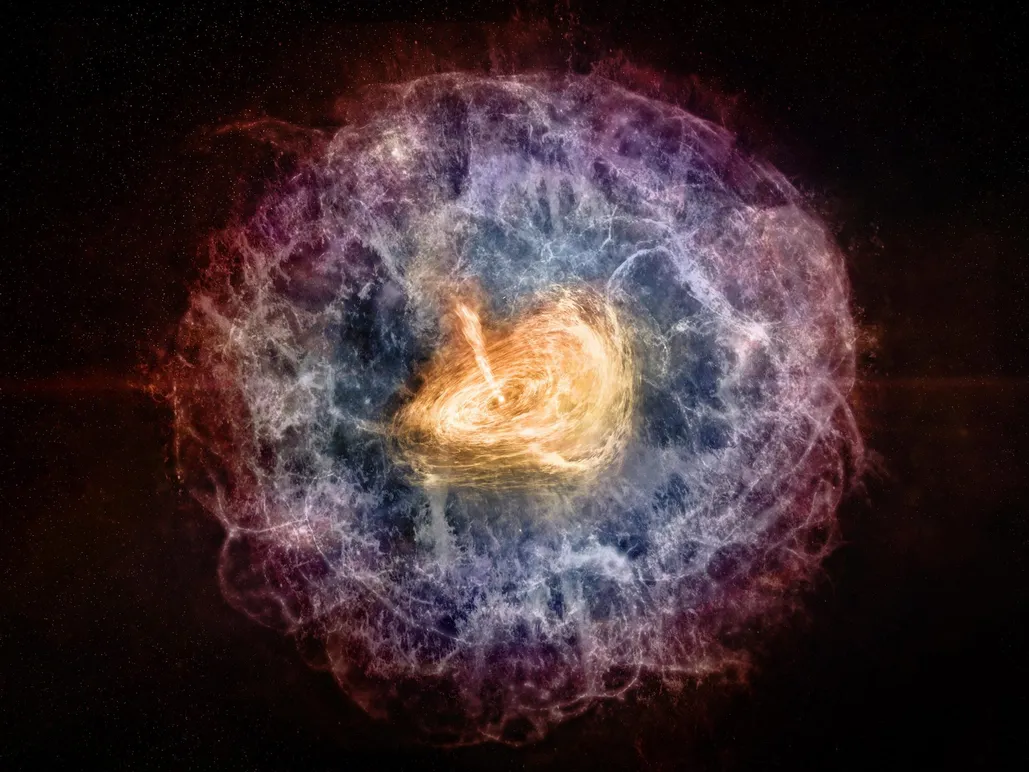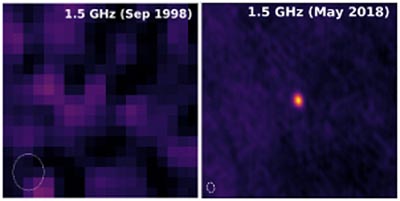
W miarę jak skorupa szczątków po wybuchu supernowej rozszerza się przez kilka dziesięcioleci, staje się mniej gęsta i ostatecznie staje się na tyle cienka, że fale radiowe z wnętrza mogą uciec. Umożliwiło to obserwacjom VLA Sky Survey wykrycie jasnej emisji radiowej spowodowanej silnym polem magnetycznym szybko wirującej gwiazdy neutronowej przemierzającej otaczającą przestrzeń, przyspieszając naładowane cząstki. Zjawisko to nazywa się Mgławicą Wiatru Gwiazdowego. Źródło: Melissa Weiss, NRAO/AUI/NSF
Astronomowie analizujący dane z przeglądu nieba VLA (VLASS) odkryli jedne z najmniejszych znanych danych gwiazdy neutronowe Super gęsta pozostałość masywnej gwiazdy, która eksplodowała w postaci Supernowa. Zdjęcia z National Science Foundation’s Bardzo duża kolekcja Karla G. Jansky’ego (VLA) Wskazuje, że jasna emisja radiowa jest zasilana przez obrót[{” attribute=””>pulsar’s magnetic field has only recently emerged from behind a dense shell of debris from the supernova explosion.
The object, called VT 1137-0337, is in a dwarf galaxy 395 million light-years from Earth. It first appeared in a VLASS image made in January of 2018. It did not appear in an image of the same region made by the VLA’s FIRST Survey in 1998. It continued to appear in later VLASS observations in 2018, 2019, 2020, and 2022.

Top Left: A giant blue star, much more massive than our Sun, has consumed, through nuclear fusion at its center, all its hydrogen, helium, and heavier elements up to iron. It now has a small iron core (red dot) at its center. Unlike the earlier stages of fusion, the fusion of iron atoms absorbs, rather than releases, energy. The fusion-released energy that has held up the star against its own weight now is gone, and the star will quickly collapse, triggering a supernova explosion. Top Right: The collapse has begun, producing a superdense neutron star with a strong magnetic field at its center (inset). The neutron star, though containing about 1.5 times the mass of the Sun, is only about the size of Manhattan. Bottom Left: The supernova explosion has ejected a fast-moving shell of debris outward into interstellar space. At this stage, the debris shell is dense enough to shroud from view any radio waves coming from the region of the neutron star. Bottom Right: As the shell of explosion debris expands over a few decades, it becomes less dense and eventually becomes thin enough that radio waves from inside can escape. This allowed observations by the VLA Sky Survey to detect bright radio emission created as the rapidly spinning neutron star’s powerful magnetic field sweeps through the surrounding space, accelerating charged particles. This phenomenon is called a pulsar wind nebula. Credit: Melissa Weiss, NRAO/AUI/NSF
“What we’re most likely seeing is a pulsar wind nebula,” said Dillon Dong, a Caltech graduate student who will begin a Jansky Postdoctoral Fellowship at the National Radio Astronomy Observatory (NRAO) later this year. A pulsar wind nebula is created when the powerful magnetic field of a rapidly spinning neutron star accelerates surrounding charged particles to nearly the speed of light.
“Based on its characteristics, this is a very young pulsar — possibly as young as only 14 years, but no older than 60 to 80 years,” said Gregg Hallinan, Dong’s Ph.D advisor at Caltech.
The scientists reported their findings at the American Astronomical Society’s meeting in Pasadena, California.

A giant blue star, much more massive than our Sun, has consumed, through nuclear fusion at its center, all its hydrogen, helium, and heavier elements up to iron. It now has a small iron core (red dot) at its center. Unlike the earlier stages of fusion, the fusion of iron atoms absorbs, rather than releases, energy. The fusion-released energy that has held up the star against its own weight now is gone, and the star will quickly collapse, triggering a supernova explosion. Credit: Melissa Weiss, NRAO/AUI/NSF
Dong and Hallinan discovered the object in data from VLASS, an NRAO project that began in 2017 to survey the entire sky visible from the VLA — about 80 percent of the sky. Over a period of seven years, VLASS is conducting a complete scan of the sky three times, with one of the objectives to find transient objects. The astronomers found VT 1137-0337 in the first VLASS scan from 2018.
Comparing that VLASS scan to data from an earlier VLA sky survey called FIRST revealed 20 particularly luminous transient objects that could be associated with known galaxies.
“This one stood out because its galaxy is experiencing a burst of star formation, and also because of the characteristics of its radio emission,” Dong said. The galaxy, called SDSS J113706.18-033737.1, is a dwarf galaxy containing about 100 million times the mass of the Sun.

The star’s collapse has begun, producing a superdense neutron star with a strong magnetic field at its center (inset). The neutron star, though containing about 1.5 times the mass of the Sun, is only about the size of Manhattan. Credit: Melissa Weiss, NRAO/AUI/NSF
In studying the characteristics of VT 1137-0337, the astronomers considered several possible explanations, including a supernova, gamma ray burst, or tidal disruption event in which a star is shredded by a supermassive black hole. They concluded that the best explanation is a pulsar wind nebula.
In this scenario, a star much more massive than the Sun exploded as a supernova, leaving behind a neutron star. Most of the original star’s mass was blown outward as a shell of debris. The neutron star spins rapidly, and as its powerful magnetic field sweeps through the surrounding space it accelerates charged particles, causing strong radio emission.
Initially, the radio emission was blocked from view by the shell of explosion debris. As that shell expanded, it became progressively less dense until eventually the radio waves from the pulsar wind nebula could pass through.

The supernova explosion has ejected a fast-moving shell of debris outward into interstellar space. At this stage, the debris shell is dense enough to shroud from view any radio waves coming from the region of the neutron star. Credit: Melissa Weiss, NRAO/AUI/NSF
“This happened between the FIRST observation in 1998 and the VLASS observation in 2018,” Hallinan said.
Probably the most famous example of a pulsar wind nebula is the Crab Nebula in the constellation Taurus, the result of a supernova that shone brightly in the year 1054. The Crab is readily visible today in small telescopes.
“The object we have found appears to be approximately 10,000 times more energetic than the Crab, with a stronger magnetic field,” Dong said. “It likely is an emerging ‘super Crab’,” he added.

VLA images of the location of VT 1137-0337 in 1998, left, and 2018, right. The object became visible to the VLA sometime between these two dates. Credit: Dong & Hallinan, NRAO/AUI/NSF
While Dong and Hallinan consider VT 1137-0337 to most likely be a pulsar wind nebula, it also is possible that its magnetic field may be strong enough for the neutron star to qualify as a magnetar — a class of super-magnetic objects. Magnetars are a leading candidate for the origin of the mysterious Fast Radio Bursts (FRBs) now under intense study.
“In that case, this would be the first magnetar caught in the act of appearing, and that, too, is extremely exciting,” Dong said.
Indeed some Fast Radio Bursts have been found to be associated with persistent radio sources, the nature of which also is a mystery. They bear a strong resemblance in their properties to VT 1137-0337, but have shown no evidence of strong variability.
“Our discovery of a very similar source switching on suggests that the radio sources associated with FRBs also may be luminous pulsar wind nebulae,” Dong said.
The astronomers plan to conduct further observations to learn more about the object and to monitor its behavior over time.
The National Radio Astronomy Observatory is a facility of the National Science Foundation, operated under cooperative agreement by Associated Universities, Inc.

„Amatorski przedsiębiorca. Profesjonalny ekspert od internetu. Człowiek zombie. Nieuleczalny badacz popkultury”.
